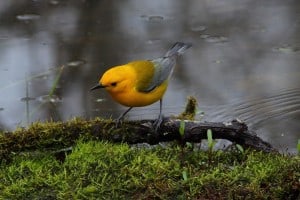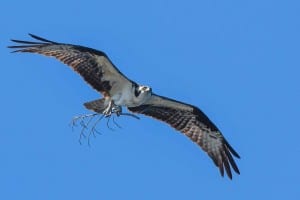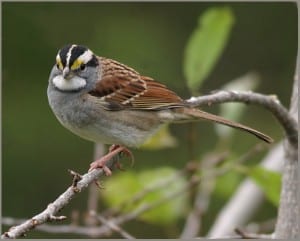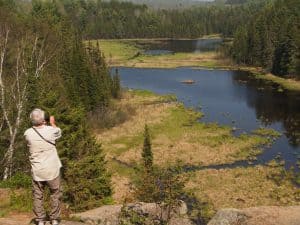When we debarked from the shuttle that takes birders out to the tip of Point Pelee National Park, it was clear that something was up. Hundreds of people lined the trail along the west beach, fully engrossed by the activity around them. Birds were everywhere – on the ground, flitting about in trees and shrubs, and even perched out in the open. I had never seen so many smiling faces in my life. Decades ago, birders would say that there are days at Pelee when the birds are “dripping from the trees”. Now, for the first time ever, we were witnessing one of these days ourselves.
In addition to large numbers of white-crowned and white-throated sparrows, most of the migrants were warblers, a group highly coveted by birders in the spring. The variety of species and sheer number of individuals was overwhelming. Just in our section of the trail, there were dozens each of Cape May, black-throated green, northern parula, American redstart, chestnut-sided, palm and blackburnian – just to name the most abundant. It was a veritable feast for the eyes. The majority were males, adorned in the stunning yellows, oranges and reds of spring plumage. Many of the birds moved through in waves, sometimes making their way northward up the tip but then changing direction and heading back out towards the lake. At times, it was hard to know where to look, especially since people were continually yelling out rare species. I could simply focus my binoculars on a given branch only metres away and the birds would move through my field of vision. They paid no attention to the awe-struck crowd, but were strictly focused on gorging themselves on the midges that swarmed in and around the vegetation. When we turned our attention skyward, other species streamed by overhead. The oohs and awes were loudest when a red-headed woodpecker, followed by six eastern bluebirds, flew by.
All I could hear were superlatives: “The best morning in decades!” ….”This is amazing!” …”C’est incroyable!” Everywhere, there was a constant clicking of cameras. I can only imagine some of the stellar images that must have been captured. Despite the excitement, there was no pushing or shoving, even as people rushed by to catch a glimpse of a rarity like a Cerulean or Canada warbler. As birders always do, people helped each other locate and identify the birds. After three hours of uninterrupted action and suddenly aware of our aching necks and shoulders, we finally headed back to the visitor centre, thrilled with having tallied no less than 20 warbler species, not to mention numerous flycatchers, kinglets, gnatcatchers and others.
Over coffee and muffins provided by the Friends of Point Pelee, people shared theories as to why this amazing “fallout” of birds had occurred. Up until that morning, birding had been quite slow. So, what had changed? It seems that winds from the south had materialized the evening before, allowing a huge backlog of birds on the Ohio side of Lake Erie to finally head northward. Sometime in the early morning hours, however, the winds had changed to the northeast and, not able to fly against the strong headwind, the thousands of migrants descended en masse on the first land available – the tip of Point Pelee.
Over the four days at Pelee and one day at Rondeau Provincial Park, we tallied no less than 140 species, ranging from the warblers described above to large numbers of avian gems like scarlet tanagers, rose-breasted grosbeaks, black-bellied plovers, and both Baltimore and orchard orioles. We were also treated to a great horned owl nest containing three very inquisitive owlets. Close-up views of more than 100 short-billed dowitchers were a real treat, as well.
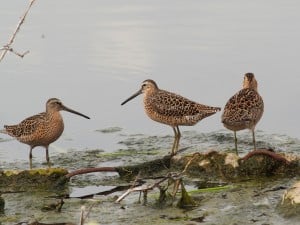
Short-billed Dowitchers – Blenheim Sewage Lagoon near Rondeau Provincial Park – May 12, 2016 Drew Monkman
Bearing witness each year to the wonder of spring migration provides a tangible sense of the change of season and a profound feeling of reverence. How can you not be amazed at tiny songbirds that have used solar and magnetic orienteering to fly from the rainforests of Central and South America all the way to Canada? It is no less than an affirmation of life itself and the wonder of evolution.
Baxter Creek
You don’t have to travel all the way to southwestern Ontario to enjoy the birds of spring. The Kawarthas offers numerous locations to enjoy rich birdlife. Upon my return, a friend and I spent an especially pleasant morning walking the Baxter Creek Trail, which is part of the Millbrook Valley Trails system, located on the edge of Millbrook. The first birds we saw were arctic-bound lesser yellowlegs and pectoral sandpipers that were feeding in the shallows of the millpond. As we watched, we could hear the shrill whistles of an Osprey soaring overhead and the clattering rattle of a belted kingfisher.
Black-throated green warblers, winter wrens and a wood thrush were singing in the deeply shaded cedar forest at the trailhead. Together with the rays of sunlight streaming through gaps in the canopy, the songs created a cathedral-like ambience. An exquisite patch of red trilliums in full bloom enhanced the feeling of connection with the natural world. The trail then winds through rich wetland where the voices of yellow warblers and common yellowthroats competed with beautiful marsh marigolds for our attention. We also had great views of a male rose-breasted grosbeak pouring out its robin-like phrases from the top of a giant black willow. Some birders remember the song as “a robin that has taken voice lessons.” As crazy as it sounds, memory aids like this really work. Other birds of note heard or seen along the trail that morning included great crested flycatcher, black-and-white warbler and eastern kingbird. Spring azure butterflies were also quite common. Shaded pools along the creek make a great place to sit and simply soak in the tranquility of the area. After the walk, we stopped for a great lunch at the Pastry Peddler on King Street in the village.
Algonquin Park
Savoring the rich diversity of May nature is not complete without a trip to Algonquin Park. I fell in love with the park on my very first visit in September of 1964 when my father took me on three-day canoe trip. I still remember the stunning leaves at peak colour and the schools of brook trout in the Crow River. Doug Sadler, a well-known local naturalist, writer and mentor to many young birders in the Peterborough area, also came along and helped me to identify my first-ever gray jay – a huge thrill for a twelve year-old.
So, when our friends Mike and Sonja Barker invited Michelle and I up to their campsite at the Lake of Two Rivers Campground last week, we jumped at the opportunity. Their site overlooked a wetland that was alive with bird and beaver activity. Algonquin’s signature sound – the high clear whistle of the white-throated sparrow (“Oh sweet Canada, Canada, Canada”) – was everywhere. The highlight of the visit, however, was riding the Old Railway Bike Trail from Lake of Two Rivers to Cache Lake. The trail follows the abandoned bed of the historic Ottawa, Arnprior, and Parry Sound Railway and winds through a variety of different habitats such as open field, coniferous forest and wetland. Only metres down the trail, the strangely gentle tapping of a woodpecker caught my attention. Sure enough, a beautiful male black-backed woodpecker was flaking bark off a red pine, only a couple of metres above our heads. The all-black back and alluring yellow crown make it quite different from any other woodpecker.
Riding along the trail through thick stands of fragrant balsam fir, we stopped to take pictures of a remnant block of ice, hidden away in a rocky crag. Our attention was also drawn to numerous patches of trailing arbutus, which was still in bloom and smelled wonderful. At least 10 species of warblers were singing along the trail including the Tennessee, a bird of the boreal forest that reaches the southern edge of its breeding range in Algonquin Park. Another highlight was an olive-sided flycatcher that Mike heard calling (“quick, three beers!”) from a huge marsh we passed through. The trail crosses the scenic Madawaska River in several locations where we stopped to admire the many shades of green on the distant hills. Because Algonquin Park is so much higher in elevation than the Kawarthas, most of the trees were just coming into leaf. Some, like bigtooth aspen were still leafless. The trail is flat along its entire length and has numerous interpretive signs. There are even washrooms at the Cache Lake end.
The next day, we walked the Beaver Pond Trail, which is an easy two kilometre loop offering excellent views of two beaver ponds and a classic beaver dam. The free guidebook at the trailhead provides an introduction to Algonquin’s fascinating beaver pond ecology. Before leaving the Park, we also stopped by the Visitor Centre, which has one of the best nature bookstores in all of Canada. There are also interactive exhibits on the Park’s human and natural history.
I feel so fortunate this year to have been able to get out and enjoy so much of what May has to offer. Although it’s hard to talk of a favourite month, for anyone who takes pleasure in watching the seasons unfold, May has no equal. And, by the way, June is pretty good too!
